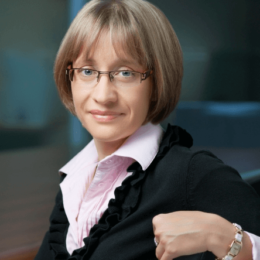The general issue of what a trademark is and its legal definition was already discussed in the previous parts of this series. Apart from the most popular trademarks, such as word, word-figurative or figurative marks, and in addition to unconventional marks already discussed – there still remain a few other kinds of marks to be mentioned. This time let’s have a closer look at a multimedia trademark.
A multimedia trademark is a mark being a combination of sound and image, or a mark which transfers itself into such combination of sound and image. Additionally, this kind of mark may also include words or elements graphic.
Upon filing an application for registration of a multimedia trademark, it has to be represented in the form of an audiovisual file showing the combination of the image and sound – the file shall be regarded as a representation of the mark.
As regards the formats of audiovisual files, which are acceptable for the Patent Office, these are MP4 files and their size should not exceed 50MB.
If a multimedia trademark is applied electronically, an audiovisual file presenting the mark can simply be attached to the electronic application. On the other hand, if the application is filed traditionally, that is – in paper format, the representation of the mark has to be attached on the appropriate electronic carrier, such as a pendrive, CD or DVD.
Below there are a few examples of trademarks applied for registration, or registered by EUIPO and the Polish Patent Office:
EUTM-017279704 IFORI INTELLECTUAL PROPERTY & ICT LAW – a trademark registered in the EUIPO in the name of IFORI from Belgium for services in class 45: “Intellectual property services; legal services.”
EUTM-017451816 – a trademark registered in the EUIPO in the name of Fahnen-Gärtner GmbH from Austria for goods in classes 06, 16 and 24, namely: „Flagpoles of metal; Flags of paper; Bunting of textile or plastic; Cloth bunting; Flags of textile or plastic.”
EUTM-017931160 – a trademark registered in the EUIPO in the name of ZITRO IP S.àr.l from Luxemburg for goods and services in classes 09, 28 41, including among others „Apparatus for recording, transmission or reproduction of sound or images; Magnetic data carriers, recording discs; Games of chance, with or without the awarding of prizes, for use in telecommunications apparatus (software); Bingo games for betting machines (software); Jackpot games for betting machines (software); Computer software applications, downloadable; Software for mobile devices; Mobile apps.; Bingo games; Jackpot games; Automatic coin-operated games; Automatic games other than those adapted for use with television receivers only; Slot machines; Arcade game machines, including machines for amusement arcades and gaming rooms; Gaming machines operated by coins, tokens or any other means of pre-payment; Automatic amusement machines; Free-standing video games apparatus; Electronic hand-held game units; On-line gaming services; Organization of competitions; Operating of lotteries; Providing gaming house facilities; Gaming service; Entertainment and recreation information, including an electronic bulletin board with information, news, advice, and strategies about electronic, computer and video games; Casino services; Online casinos; Provision of entertainment facilities; Amusements and game machine rental services.”
EUTM-018061546 – a trademark applied in the EUIPO in the name of Chiever B.V. from the Netherlands for goods and services in classes 16, 33, 41, including among others: “books; wine; entertainment and cultural services.”
Z.502930 pio pio 23 – a trademark applied in the Polish Patent Office in the name of FABRYKA FUTBOLU SPÓŁKA Z OGRANICZONĄ ODPOWIEDZIALNOŚCIĄ I WSPÓLNICY SPÓŁKA KOMANDYTOWA from Poznań [the company being the agent of a Polish football player – Krzysztof Piątek; the applied mark represents the famous gesture, which the player demonstrates to celebrate scoring a goal] in respect of goods and services in classes 09, 35, 36, 38, 41, including among others: „computer databases; music, movies and other kinds of image and text electronic publications recorded on carriers; production of advertising materials and advertisements, distribution of advertising, marketing and promotional materials, advertising services, marketing and promotional services, marketing campaigns, presentation of products in media for retail sale purposes, publicity and sponsored texts, publication of advertising materials, advertising and promotional services relating to sales, advertising and promotional services by means of television, radio, mail, consumer marketing research and consumer behavior research services, consumer trend analysis, exhibitions for commercial or advertising purposes, providing of commercial information to consumers, commercial agency, sales promotion services, loyalty, motivation and promotional program services, marketing campaigns, advertising management, conducting of competitions and gambling games for advertising purposes, sponsoring sport activities; telecommunication services; organization of games and competitions.”
What is essential to note, when applying for registration of a multimedia trademark it is not necessary to attach a description of the mark – as the representation of the mark by itself determines the subject of protection.
Upon filing an application for a multimedia mark, it is also important to remember that this kind of marks cannot be represented in the form of a composition of motionless images with addition of audio contents on a separate carrier, or by means of two separate carriers for presenting the contents of the mark, one of which contains an audio file, and the other one a graphic file.
Multimedia trademarks – like any other kinds of marks – are the subject of examination conducted by the Polish Patent Office to determine whether or not there exist any potential obstacles to granting protection for these marks.
Consequently, it is advisable for the applicants to make sure that an average consumer perceives the changing images along with the accompanying sound as a trademark, and also that such mark contains sufficiently distinctive elements, which allow the consumer to remember it by means of one cognitive act.
The Polish Patent Office (PPO), or the European Union Intellectual Property Office (EUIPO), in the course of examination of a multimedia trademark application, may deny the grant of the right of protection if:
- the multimedia mark incorporates too many elements;
- the multimedia mark, in its overall conception, incorporates the elements, which are inseparably connected with the product itself for which the mark is destined, or the elements are descriptive in relation to the properties of that product.
Therefore, if you have an idea for the marking of your goods or services by means of a multimedia trademark, but you are not sure whether the mark fulfills 100% of the requirements and will be regarded as distinctive, in order to clear any doubts you are recommended to rely on the services of a professional patent attorney, experienced in the proceedings both before the PPO and EUIPO.
If you have an idea for a trademark including the elements in motion, but not combined with the sound, you may consider the filing of a motion trademark, which will be discussed fairly soon in the next part of this series.

Agnieszka Skrzypczak is a patent attorney specializing in trademarks and industrial designs. In 2002, she obtained the rights of a Polish Patent Attorney, and since 2004, she is also a European Patent Attorney. She is a member of INTA (International Trade Marks Association) and PIRP (Polish Chamber of Patent Attorneys). Contact with the author

